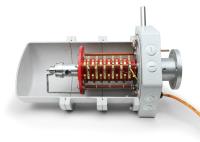 Add My Company
Add My Company
Sign In
What is a Slip Ring?
15-02-2023

What is a Slip Ring?
Slip rings, which are an essential component in many rotating systems, are electromechanical devices that allow the transmission of power and electrical signals from a stationary to a rotating structure, (‘or vice versa’).
Also called a rotary electrical joint, collector or electric swivel, slip rings have a wide range of applications in various industries. They can be used in any electromechanical system that requires a level of rotation while transmitting power, such as aerospace, defence and industrial automation systems.
Slip rings can improve mechanical performance, simplify system operation and prevent wires from tangling, allowing the smooth transfer of power and data between rotary systems. Browse our range of slip rings and slip ring assemblies at BGB today.
How Do Slip Rings Work?
A slip ring consists of two main elements: rings and brushes. The rotating ring and stationary brushes make contact with each other to transfer electrical energy.
(‘At a base level, a slip ring consists of two main elements; the ring(s) and the contact technology. Although there are also great advancements being made in relation to contactless technologies with relation to rotary transfer systems.’)
The ring is made out of an electrically conductive metal, such as brass, plated silver or coin silver (‘material selection will differ based on system requirements.’). This element provides the circuit path and is usually mounted on a centre shaft. (The rings would only provide half of the circuit path).
The brushes sit on arms that are attached to the side posts that ride on the ring, providing the electrical contact and connecting the rotating and stationary parts. They are made of different conductive materials, such as copper graphite or silver graphite. (‘The contacts are mounted through various means in order to make the most effective ring contact. These contacts are made from different materials and come if various different forms, with selection depending on system requirements’)
Slip rings can rotate at a variety of speeds, depending on the application. The slip ring rides along a centre shaft and sits on a base plate. The base plate is held stationary, while the shaft rotates in the centre. (‘Predominantly these systems are designed so as to have the rings act as the rotational portion of these passive systems, driven either by a flange interface or interfacing with the shaft, with the brushes acting as the stationary portion, usually mounted within the housing portion of the units and held in position by use of a torque arm.’) This allows the slip ring to transfer electrical power from a stationary system to a 360-degree rotating unit, completing the circuit.
Slip Ring Applications
Slip rings are commonly used in electric motors, generators, wind turbines, and radar antennas, where they play a crucial role in enabling continuous rotation. In electric motors, slip rings allow the transmission of electrical signals and power to the rotor, which is needed for the motor to work effectively.
In generators and wind turbines, they transfer power from the rotating blades to the stationary generator and in radar antennas, slip rings enable the rotation of the antenna without interrupting the transmission of electrical signals.
Slip rings are used in industrial automation machinery and equipment. They are often used in automated assembly lines and packaging machinery, where continuous rotation is required for the system to efficiently operate.
Key Advantages of Slip Rings
One of the main advantages of slip rings is their reliability. Since they allow the transfer of power and signals without any physical (‘hardwired/fixed’) connection(s) between the stationary and rotating structures, they are less prone to wear and tear compared to other types of connectors (‘through controlled system wear’). Without slip rings, cables and wires would be twisted and tangled, causing damage to the electrical connection and limiting the range of motion of the rotating part.
Because they are less susceptible to wear and tear, slip rings require minimal maintenance. This reduces the overall cost of ownership of a machine or system, as less time and money is put into maintenance and repair.
Additionally, slip rings can be customised to meet specific requirements for a particular application, such as the operating speed, temperature range, and the degree of environmental protection required. Slip rings are available in a wide range of sizes, shapes, and materials, so they are highly customisable and flexible.
Overall, slip rings offer a reliable, efficient, and cost-effective solution for transmitting electrical signals and power in rotary applications.
BGB is a leading slip ring manufacturer. Our range of robust standard slip rings lends itself to a multitude of application speeds. Get in touch with our experts to find out more!
For more information on What is a Slip Ring? talk to BGB
Enquire Now
List your company on FindTheNeedle.

